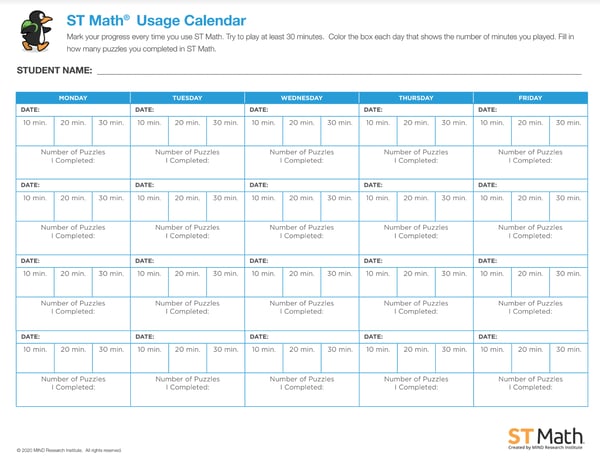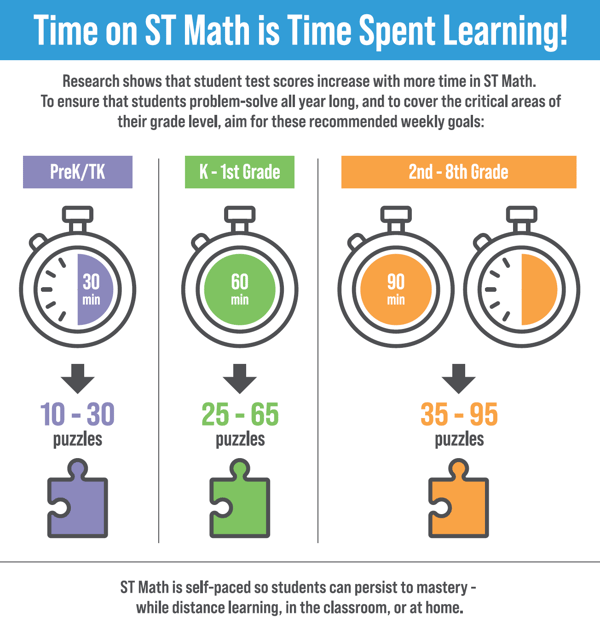This article features contributions from MIND Research Institute's Director of Product, Twana Young, and Senior User Experience Researcher, Alesha Arp.
Individual vs Group Goals
I learned the value of individual goal setting as a high school cross-country and track runner. My coach, Dave Donaldson, taught all of his runners to set goals and then aim beyond them. His philosophy was that you didn’t want to just run to the top of the hill, but over the top.
Today, my goals are not as speedy, but they’re no less “over the top” and I am always heartened when I visit schools where students can articulate their goals and can share how they’re working toward achievement.
In the current version of ST Math, the primary metric is percent progress. Students across the country are recognized on class bulletin boards and in school assemblies for achieving a targeted progress percentage, whether that’s 25% per quarter, or 70% by spring break, or 100% by the end of the school year. These celebrations are wonderful and the sense of pride that students have in this accomplishment is evident by their smiles.
However, focusing on one single metric for all students can be exclusionary. Sometimes a one-size-fits-all goal centers too much on extrinsic motivation.

Oftentimes it’s the stars on the bulletin board, or the popsicle party at the end of the year that drives kids to reach their percent progress goal. If you ask the student the value of achieving that goal, they’re not going to tell you what they learned about problem solving, goal setting, and perseverance. They’re going to tell you they wanted to attend the popsicle party.
If a student doesn’t reach the school- or class-wide 25% progress mark by the end of the first quarter (or 33% for the trimester), they start every subsequent grading period behind, and the hill they need to climb to overcome that deficit can be insurmountable. Some never catch up.
By the same token, some students reach 100% quickly, and then have no motivation to deepen their exploration or understanding of the concepts.
I spoke with a teacher in Oakland, CA early this spring who lamented that the kids who get recognized at their weekly assembly are typically those students who have access to devices and internet at home. She feels this celebrates the “haves” and leaves out the “have-nots.” While their students without device access at home benefit from the time they play ST Math in school, it is not likely—with their current program implementation—that these students will reach 100% progress.
The administrator, curriculum coach, and teachers are all working to alter their implementation, but until that comes to fruition, a vast majority of the students are striving toward an unattainable goal. I would propose differentiating and encouraging students to set and track their own goals.
Revising the Focus
With the redesign of ST Math due out for the 2020-21 school year, differentiation will be easier for teachers to employ and students will have direct visibility into metrics they can influence. But we do not need to wait until next school year to individualize student goals.
With students now learning at home, individual accountability gives kids more control at a time when they likely feel they don’t have a lot of control.

Tracking Individual Accountability
To better understand what is available for parents and teachers working remotely to use now with their kids, I invited Twana Young, MIND’s Director of Instructional Development, into the conversation. Twana is one of our thought leaders here at MIND Research Institute. She brings a rich background to her work as an educator and former district administrator experienced in developing curricular programs at the local, state, and national level.
Twana has rich experience building, supporting, and monitoring STEM-rich environments. I asked Twana, “How can teachers foster individual accountability for their students now?”
With so much talk of what students are missing out on by not being in school, there are some great opportunities that exist to build student agency, accountability, and confidence in mathematics. In our current ST Math program when students complete their session, they are taken to their My Accomplishment’s page.
This page highlights the amount of time, the progress, number of puzzles, and levels the students mastered during this session.

Having this type of explicit data provides a great opportunity for students to identify appropriate goals, set action steps to achieve the goals, monitor their progress toward the goals, and learn to adjust the goals based on the data.
“Are there ways parents can support their students’ learning with little management time?”
To support student goals we have developed an ST Math Usage calendar. Students can identify a goal at the beginning of the week based on the number of minutes of ST Math or the number of days to play ST Math. Students can track their goals by recording their progress on the ST Math Usage calendar. Students should be encouraged to share their goals with family and discuss how they plan to achieve them.
 Download the Spanish version>>
Download the Spanish version>>
Twana cautioned though, that usage goals are not the only way students can track achievement.
In addition to usage goals, it is important for students to set and work toward academic goals. Because ST Math is a mastery-based visual, spatial program, students are able to have confidence that they are growing in mathematical understanding as they play.
They may set academic goals related to number of objectives completed, math concepts learned, hurdles overcome, classroom connections made, etc. As students communicate their academic goals, they should also communicate what they are learning. This will support them in developing a deep understanding of content, transferring and applying knowledge, and learning how to effectively communicate.
Math journals are great resources for students to reflect on their ST Math session, process their thinking, communicate what they have learned, and monitor their progress toward their academic goals.
Empowering Students to Set and Achieve Goals
Thinking back again to my high school running days, I can assure you, I never would have run a sub-5:30 mile for my coach, no matter how supportive and encouraging he was.
- I had to set that goal for myself, and do the work to consistently run a mile in under five-and-a-half minutes.
- I had to solve the problem of not having enough practice-time after school, by running extra practices in the dark before school.
- I had to persevere through the 40 repetitions up and down the nearby junior college stadium steps each week.
Helping students set, own, and achieve individual goals is so much more powerful than giving them stars and popsicles. Had my coach set a team-goal some would have achieved it, while others wouldn’t have come close. Had he set the sub-5:30 goal for me in my freshman year, I’d have ended that season well-short and feeling unaccomplished.
I asked Twana, “What are the greatest advantages to kids being accountable for their learning that you’ve seen?”
When students play ST Math games, they are not only deepening their understanding of math concepts, they are developing critical problem-solving skills that will lead to lasting success. Setting goals is a great way to build on that and increase opportunities for student agency and accountability. Students will not only develop confidence but will more readily recognize their progress and growth.
Goal setting can also strengthen students’ ability to communicate about what they have learned and accomplished, as well as identify areas in which they would like to improve. In addition, students will learn how to manage their time better, focus on challenges, and develop plans to overcome them.
“Wow, these are the skills all of our kids will need to succeed in the workforce of tomorrow!”
Individual Goals Support Differentiation and Inclusivity
Next year’s redesigned ST Math will shift the focus to minutes spent and puzzles completed (a puzzle is one math problem within a level of a game). Regardless of what content students are playing, they will be able to see that they have spent x number of minutes and achieved y number of puzzles. This will allow for differentiated learning in tandem with individual goal setting and accountability.

Teachers will have the ability to assign content from any grade level to any student or group of students. For students struggling with a concept, the teacher can assign scaffolding concepts to build up their foundational skills. For students who excel and need a greater challenge a teacher might offer more advanced concepts. This will allow different students to traverse varied paths through the ST Math content.
Students at all points in the learning curve—those who struggle to those who excel—will be able to set goals based on the available metrics: minutes spent, and puzzles achieved. Students are, after all, individuals. The student who has trouble staying focused might have a very different goal than the student who speeds through without retention or the student who seeks help at the first sign of difficulty.
Just like I did with my dark-morning workouts, a student can control the time and the focus they put into ST Math. Even a student who doesn’t have device access from home, can be most productive with their allotted time by signing in and getting to work right away. They could set a puzzles per minute goal and work to achieve that.
My first goal when I joined the cross-country team was to break 8 minutes in the mile. Over time, as each goal was attained, a new goal was set.

If students have an achievable minutes goal and awareness of the average number of puzzles they typically achieve, they can work to increase that week over week. If they’re spending time visiting with their seatmate, this will be evidenced in that ratio; they can then adjust and can take full advantage of the time allotted by spending each minute productively.
Running the same mile-time on a hilly cross-country course, or in mud is not as achievable as running it flat-out on a track.
When students are met with a really difficult concept, and their puzzle count drops, they can talk about that and adjust. Kids can learn to adjust their goal for the conditions and readjust when conditions are more favorable.
A student who needs scaffolding content to build their foundation, likely won’t complete all the grade-level content in that school year, however they can improve their math competency, problem-solving abilities, and their perseverance by setting and achieving their own goals.
I have visited classrooms where they haven’t yet figured out how to get 60 or 90 minutes of time worked into their weekly schedule. But motivated students opt-in to ST Math during “free-tech” time or “free-learning” time—which usually happens on Fridays when teachers are wrapping up lessons with students who were absent during the week. If students have ownership of and accountability for their own goals, they are more likely to opt-in.
Additional Resources


from MIND Research Institute Blog https://ift.tt/3iffu0v
Alesha Arp
















